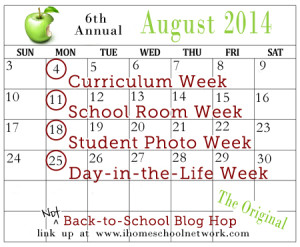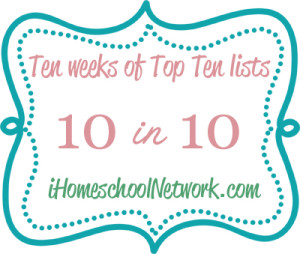 Hi, I'm Heidi and I homeschool my two sweet kids. I want them to know that learning is an exciting lifelong adventure! We love great books, unit studies, notebooking, lapbooking, and hands-on learning.
Hi, I'm Heidi and I homeschool my two sweet kids. I want them to know that learning is an exciting lifelong adventure! We love great books, unit studies, notebooking, lapbooking, and hands-on learning.Daily Homeschool Schedule
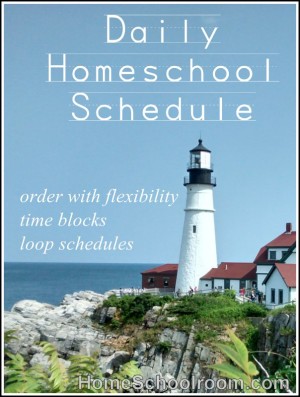
Want to follow along on a day in our homeschool? Let me share a bit about past year schedules, then we’ll get down to this year’s daily details.
A Brief History
My natural tendencies are to be a list-making drill sergeant task master. I can take the fun out of just about anything…but I’m maturing every year. This is our fourth year, and the history flows something like this:
- When I started homeschooling my kids (then ages 6 and 9) I planned our day on a spreadsheet with fifteen minute increments. I had a little icon showing which child I was working with. I spent a lot of time planning, and most of my plans were mom-intensive. I’m stressed just remembering it!
- By year two I ditched the small time slots, but still planned way too much, felt like I was running a dog-and-pony show, and never ever felt we had done enough.
- Our third year was much better. I learned to decrease my over-planning, stop making education “mom’s circus show,” and started working with blocks of time. I was finally finding the balance of a time-based schedule but with flexibility.
Ready to Start a New Year
Here we are at year four! I’ll still be using the scheduling that worked last year, like blocks of time, with a few extra things to keep me on track (and out of the stressed-out-and-grumpy-homeschool-mom category):
- When I am filling in our blocks, whether it’s individual work or the time we spend together, I make my guess of how long something will take and only fill 80% of each time block. This idea came from Sara at Amongst Lovely Things. It seems radical to a reformed over-planner driven to cross things off my list, and will hopefully help me be more realistic in how much I add to my list in the first place.
- I will make loop schedules for many of our time blocks. This idea came up in several blogs I was reading over the summer, and I realized it would help me be prepared for the blocks of learning we do together without having to plan those blocks each day or worry about whether we a certain block three days or four days on a particular week. I’m hoping it will also curb my tendency to feel “behind” if I don’t complete every block daily. (I’ll give a specific example of how a loop works in the details of our day.)
- In addition to having their list own lists of individual work, I will post our schedule each day so my children can see what we’ll be doing together. When reading about the way Charlotte Mason scheduled her students I recognized that I kept the plan for the day in my head or on my personal list. My kids were left not knowing what the day looked like ahead of time, having to ask me when they’d have time for personal activities, or being surprised by having to go run errands. That’s not fair, so I’ll be better about sharing my plan.
- Last but not least is what I call a “rolling start” to our mornings. I began this late last year, and it seems to be a magical way to have everyone work at their best. I’ll explain how this works in the details of our day.
After that lengthy introduction, let me share our daily flow which is broken up into orderly blocks of time. For details on what fills these time blocks (like my children’s individual work or what resources we use at Tea Time), see my post with our 2014-2015 Curriculum.
Morning Individual Work
This is where the rolling start comes in. We have two different mornings for my very different children: My daughter (age 12) has always needed a lot of sleep and is more alert in the evenings. My son (almost 9) is the quintessential early riser. He can’t do focused work later in the day, and even if he is up late he is still unbelievably alert and cheerful at 6 AM. After trying to start the school day together and either missing my son’s most alert time or dragging a groggy daughter out of bed and trying to get her to eat breakfast when she wasn’t hungry yet, I learned to be flexible.
Morning Schedule for My Early Riser
My son and I get up by 6:30. I am not naturally a morning person and must have coffee before conversation. My son knows this so he plays while I try to lift the fog. By about 7:30 he and I sit down to breakfast together. After that we head to my bed for his first Language Arts block: he reads to me (his least favorite work of the day), then I read to him from things like picture books or nonfiction books his sister is less interested in (about bugs or spies). Reading in my bed makes this time as pleasant as possible.
Then we both get dressed and tidy our rooms, meeting back downstairs by 9:00 to spend the next two hours on his individual work. Remember, though, that even though he has 2 1/2 hours blocked out for his individual work, I only plan two hours worth of work! If he works diligently he’ll have a little free time. I give him a list of his daily work, and in Charlotte Mason fashion I keep his lessons short and varied, and he knows what must be done and how long each lesson will be.
Morning Schedule for My Late Sleeper
I allow her to wake naturally or set her own alarm. Some people may think allowing her to sleep in is lazy, but I feel I’m letting her get what her body needs and using our flexibility to it’s best advantage. I will add that she is also is focused and works well independently. She works from a weekly list with the flexibility to complete subjects when she wishes as long as the work is done without complaining. One caveat is that any of her own work not finished by the time we start our blocks together will be done on her own time later in the day. I plan on her having about three hours of individual work (remember: only 80% planned).
11:00 Tea Time
At 11:00 we come together for Tea Time, where we share a sweet treat and beautiful things. We started this last year and it has been a huge hit. I’m expanding it this year because it worked so well for fitting in the “extras” that really matter, is a great transition between individual work and working together, and because it builds our relationships. This year, with us starting school at different times, it will hold extra importance as our sort of “morning meeting.”
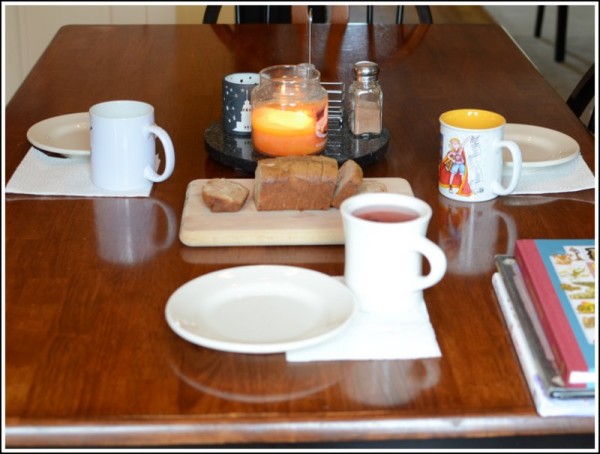
Here’s an illustration of how loop schedules work for our time blocks, using Tea Time as an example:
- Picture study
- SQUILT lesson
- Sketch Tuesday
- Listen to Classics for Kids podcast
- Poet Study
I can change the loop as needed, make a longer loop and add some things in twice if I want to do them more often…ultimate flexibility.
After we do the things that we do each time we sit down for Tea Time (like Bible reading), we just do the next thing on the loop. It helps because I don’t have to take time each day to figure out what we’ll do during Tea Time…I just do the next thing! And if we have a busy week and only have Tea Time twice that week I don’t feel I’ve missed things or am behind for the week.
11:45 Fresh Air
This is when I walk our dog. The kids can come with me, play outside in our yard, or play inside (in bad weather). This outside time is good for my health, necessary for our pet, and also gives my introverted brain a little break.
12:30 Learning Lunch
Again, my curriculum post details what might happen during our Learning Lunch. With our varied morning start times this is also when we watch CNN Student News (instead of at breakfast).
1:00 Together Time
This is when we work on the subjects that we do together with quite a bit of variety each day. I’ll use a loop schedule for this block, too. Frequently much of this time is spent reading aloud.
The Rest of the Day
By 2:00 my son is done his official schoolwork and goes off to pretend to be a secret agent or build a robotic ping pong ball shooter or heads outside to jump in leaves or snow, as the season dictates! My daughter will have individual work to finish and I’ll be available to her. I’ll usually try and take some time for my personal “Quiet Time” in my room where I read, write, plan…or just close my eyes and sit without anyone talking to me.
We’ll usually read aloud again later in the day from a chapter book for our book club or a just-for-fun book.
Disclaimer
Of course this is our typical at-home day, which is not an every day occurrence! Throw in extracurricular activities and errands, fun with friends and family, weather calling us to hike or build a snowman, or all those things that come with kids, pets and a home (The dog ate what? Everything in the freezer is melting?) and we often have atypical days. But it’s all good as long as we’re living and learning together!
Click over to the annual Day-in-the-Life blog hop to see how other homeschoolers plan their day!
Summer (School) 2014 Plans
It’s summer in Maine! (Don’t blink or you’ll miss it!) Our regular daily schedule goes out the window in favor of relaxed summer days, but that doesn’t mean we stop learning. You can read my post on year-round schooling for the why of summer school for us, in this post I’ll tell you what that looks like this year.
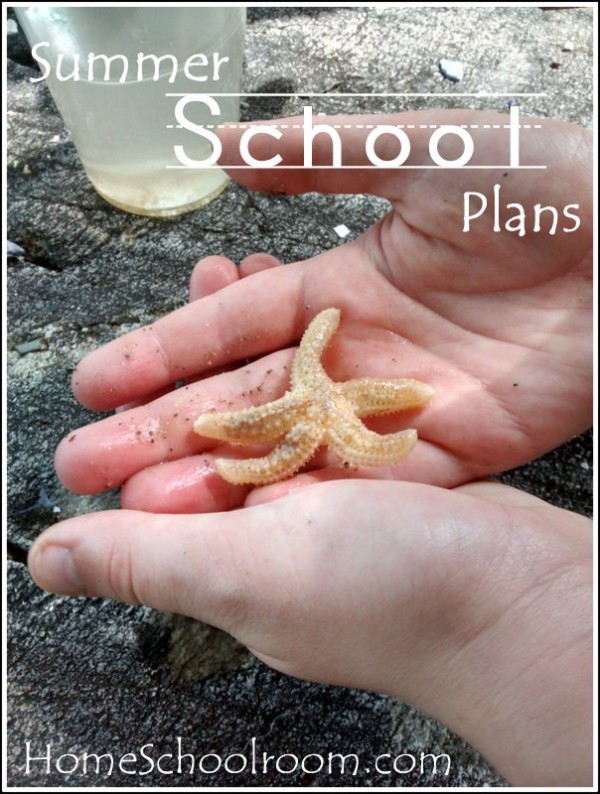
I am finding that I can loosen my reigns a little as my kids are becoming more independent learners and honing in on their own special interests. For my daughter that means plenty of time for playing piano, writing stories, and crafting (crocheting, shuttle tatting, sewing). For my son that means creative role playing, building (Lego & Lego Robotics, playdough, wood and nails…anything), and finding creatures outside.
Daily (Mostly) Independent Work
Within our relaxed schedule I keep a few required subjects going throughout the summer.
My 12-year-old daughter:
- Finish Teaching Textbooks Math 6 (less than 20 lessons left!)
- Daily piano practice (lessons continue in summer)
- Literature: read daily from a list of quality literature, her free reading is her choice
My eight-year-old son:
- Read to me (and most days a quick All About Spelling lesson right after)
- Daily guitar practice (lessons continue in the summer)
- Writing: He generally dislikes writing but enjoys a joint journal where he and I write back and forth.
Learning Together
The things we learn and do are very flexible during the summer. It involves lots of reading and taking advantage of opportunities that come our way–nature study when we’re camping at the ocean, visiting a farm on Open Farm Day, attending a Shakespeare play. I fit these in around summer fun, and chores like mowing the lawn and caring for the garden (which is a yet another learning opportunity).
History
I mentioned our school year had a bit of a soft ending, and part of that is due to our study of the Romans. So all of June and the early part of July are finding us still reading and marveling over the Roman Civilization. I want to hit on a couple more topics and maybe have a little end-of-unit celebration, then close the history books for the remainder of summer. The kids aren’t complaining a bit: today Julius Caesar was running around the house conquering (then sitting on his throne), and I acted as interviewer of Cleopatra for a video narration by my daughter.
Reading Aloud
We do a lot of reading aloud during the school year for history and science, plus a literary book club. Over the summer we’ll still read aloud together, with a theme of silly and sweet. Roald Dahl’s BFG and The Witches along with the Ramona books will take care of the silly. Then for sweet we’ll be reading Winnie the Pooh (which I keep hearing it is perfect for slightly older kids like mine), and perhaps Paddington Bear. I can’t tell you how much I love sharing stories with my children.
We also participate in our library’s summer reading program. The requirements are general and easily met by our regular reading, but my favorite parts are the special events like a puppet show and Mad Science show. I’ve also printed up the fun, free resources from Traveling Through The Pages Summer Reading Program. I like the requirements from different genres so I’m going to use this as a family reading program and see if we can complete all the squares and reward ourselves with some sort of prize.
Nature Study
We incorporate nature study regularly, but certainly it is easier during our warmer months. We camp at the seashore many times during the summer, and no matter how many times we go we always learn more. I’m trying out a couple new things this summer:
- In the past we’ve added nature journal pages to binders, but for fun this summer I bought nice hardcover sketchbooks for each of us.
- I’m not assigning what to draw, just requiring one drawing a week (and I’m including myself in the assignment–it’s good for me!). It’s more relaxed for me, and allows my children to follow their interests. My daughter often picks flowers while my son focuses on creatures.
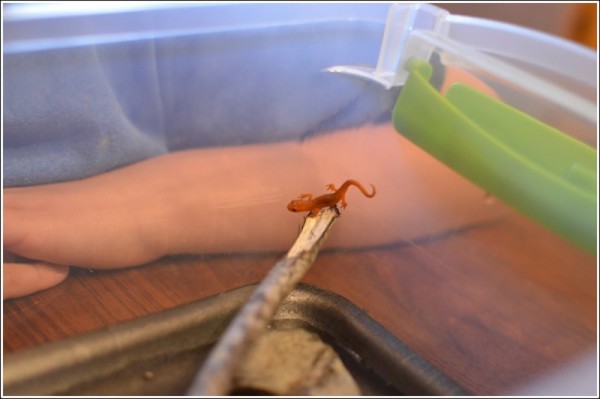
Another part of our summer nature learning is keeping temporary pets. We’ve done this before with monarch caterpillars and a katydid, but I’m focused on finding (or agreeing to) even more opportunities this summer. So far we’ve had a garter snake (that I was initially afraid to even touch), an Eastern Newt, and a Golden Ground Beetle. We learn so much by having them up close to observe, even just for a few days, and it really excites my critter-loving little boy.
Art
We love participating in Sketch Tuesday during the school year, and Barb is organizing a special summer art series on Picasso. Each Tuesday in July she’ll post an art project assignment based on one of Picasso’s works. My kids enjoy the slideshows Barb puts together of everyone’s projects, so this will be a fun way to keep art going over the summer.
So those are my relaxed summer learning plans. Just enough to keep our brains engaged but allow for lots of free time for my kids to pursue interests, and me to get rested up and geared up for next year!
How much do you plan your summer learning?
Mapping Out Our Homeschool Day

I aim to provide my children with a strong literature-based education, make time for beautiful things like fine art and music and nature study, and keep the joy in our family life. Here’s a peek into a day in our home schoolroom with a nearly eight year old boy and eleven year old girl as we enter our third year of schooling at home.
I’ll highlight some of the adjustments I’ve made to this year’s daily flow.
Rise and Shine at 6:00 AM
My early riser wakes me, already grinning and talking and planning inventions. I stumble downstairs in the general direction of coffee. He builds Legos and sometimes watches educational shows I put in our Netflix queue. I feed our dog, read a devotional, check email and snatch a few minutes to read, write, or plan.
Note: I used to read the Bible at night. Then I realized that just before bed when the house is quiet is NOT when I need the strength of God backing me up. It’s when I face the day of being mom, housekeeper, and teacher.
Get Ready for our Day at 7:30 AM
By now my daughter, now 11 and not an early riser, is awake, or I gently nudge her in that direction. We prepare ourselves and the kids tidy their rooms. They each have a checklist upstairs to prevent reminders from me to brush teeth or pick up dirty clothes.
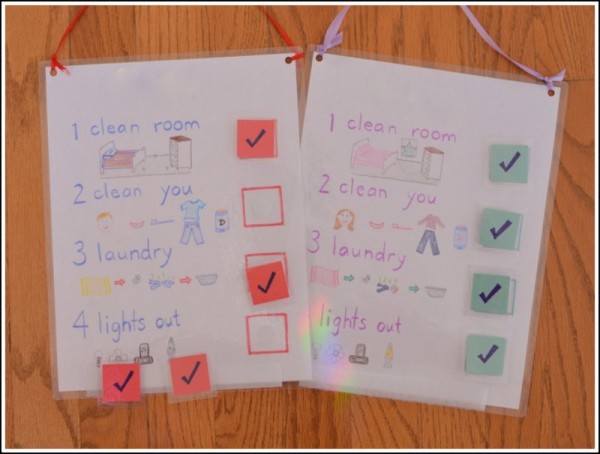
Note: We used to eat breakfast, then head upstairs to get ready for the day before coming back down to start school. Now we get ready first, then gather for breakfast and can move right into our schoolwork. It’s more efficient because we can linger at breakfast but it doesn’t hold up the flow of our day.
Breakfast and the Beginning of Learning at 8:30 AM
While eating breakfast we watch CNN Student News. It’s a 15 minute newscast meant for middle school and up, but we’ve enjoyed it for two years now. We pause frequently to discuss topics and locate places on a map. Breakfast is never dull!
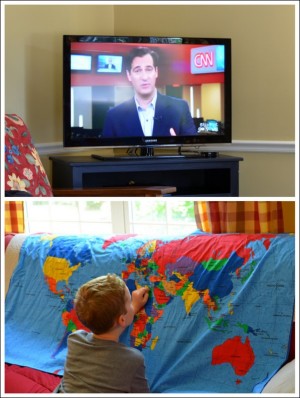
After the news we can move right into a bit of a morning meeting. I read our family devotional (this year we’re working through Our 24 Family Ways), we work on memory verses, practice Latin and Greek roots, pray and then start on individual work. For specifics of our curriculum plans for this year see this post.
My children each have weekly lists for individual work. These aren’t fancy printables, but simple checklists I create in a spreadsheet program. Some subjects must be done daily, other things 2 or 3 times a week. The lists give them direction, along with some choice and flexibility–and with that comes responsibility. If they don’t work diligently they will have to make up the work at another time.
I want to add that their lists are flexible. It says the subject, like math or Latin, but not the lesson number or specifics. That way if a particular lesson or topic is more difficult they’re not rushed. They just “do the next thing” in their subject, with daily progress as the goal.
Note: My new middle schooler probably won’t be able to finish her individual work in the morning time slot. She and I have discussed how more work is required at her age, but that we can’t extend the school day for her younger brother who (as an early riser) works best earlier in the day. So even if she hasn’t finished her individual work, she’ll pause and we’ll move into our joint subjects. She’ll finish her work either on Friday (we have four day school weeks) or later in the afternoons on quiet days.
Tea Time at 11:00
Having a hard break at the end of individual work is new for us. I shared our plans for tea time as a way to fit in our “extra” studies like fine art, music and poetry.

We’ll gather for a treat for our mind and stomach. This will provide a nice transition between the more structured learning of the basics and our subjects we delve into together.
Time to Learn Together at 11:30
This year I’m using a time block schedule instead of a list of goals. I read the idea in Educating the WholeHearted Child and see the benefits of this type of schedule.
Note: Last year I talked about not having set times, so why is going back to times actually more relaxed for me? Even though I’d realized the folly of fifteen minute time blocks, I was still over-planning. I made unrealistic lists and ended the day feeling too much was left undone. When I sat down to work with the kids I was so focused on the list that I tended to lose the joy and squash their questions because, dang it, I wanted to work quickly and cross things off my list!
There are only so many hours in a day, so much concentration they can give me, and so much patient interaction I can give them. Instead of lists I’m just blocking out the time and during specified hours I will focus on learning with them, and as long as we’re learning each day then the day is successfully completed.
A Learning Lunch at 12:30
While we eat I usually take advantage of a captive audience and we either listen to an audiobook, watch an educational show (like a science or history video), play an educational game, or work on notebooking.
A Breath of Fresh Air at 1:00
We head outside for fresh air after lunch. Some days we just take a walk around the block, other times we head somewhere a little more natural, and frequently we do a little nature study.

If it’s a nice day and they’re riding bikes or jumping in leaves or playing in snow I let them continue after I head back inside. Sometimes my son will stay out and my daughter may come in to practice piano or do other work.
Afternoon Variety
Some days we have somewhere to go: errands or educational things like music lessons, Girl Scouts or Boy Scouts, or various homeschool groups. Depending on how early we need to leave I still try to fit in quiet time, the daily habit I try desperately not to miss.
Other days where we don’t have to go anywhere right away we’ll fit in a little more learning together. We may draw a nature find, have a little hands-on fun with art, or perhaps try our hand at writing poetry. Fridays are also good days for fitting in some of these things or pursuing individual interests.
Ending the Day with Reading Aloud

I read aloud during our school day for subjects like history, science, nature study, and fine arts. Most days we’ll read aloud again sometime before bed. It could be while Dad is preparing dinner (hooray for a husband who cooks!), when we’re all cozy in the living room, or while they eat a bedtime snack.
Just after Labor Day we’ll be diving in to our full time schedule, and I have to say I’m pretty excited to start this new year. Starting Monday, August 25th, you can read how other homeschoolers structure their day in the final week of the iHomeschool Network Not Back to School Blog Hop.
Scheduling Tea Time for the Extras and 10 Tea Time Snacks

As I’ve been taking the time to reflect on our last school year and iron out what my goals and plans are for next year one thing I’m really excited to institute is a tea time. I’m planning to use it as a time to focus on those lovely “extras” that are a hallmark of the Charlotte Mason style education. We’ll sit down together over a cup of tea and a treat and share poetry and fine art and music.
Anytime I read about other homeschool moms setting aside tea time I liked the idea of making it a special time in our day. Then when I read about Elevenses from Ellen at the Bluestocking Belle I realized the 11:00 time slot would be a good fit for us, too. It will work better than an afternoon tea-time, because often by afternoon we’re either heading to an activity or errands or I’m settling them in for Quiet Time (a daily habit I can’t do without). It also will be a good time to transition between their individual work that starts our day and the subjects we study together.
Step #1 to make this a special time to look forward to in our schedule is having a sweet edible treat. I’m conscious of it being a treat, but not too unhealthy. And although I enjoy baking some days are too busy and I don’t like to have large amounts of sweet baked goods in the pantry (because then I’m tempted to eat them all day long). My answer to those problems are baking things I can freeze. That way we’ll only keep out a little for our tea time and it will also give us variety because every few days we can pull something different from the freezer.
From A to Z here are my go-to freezer-friendly sweet treats I plan to keep stocked for our tea time.
#1 Apple Bread
I use the Apple Walnut Bread recipe from Allrecipes.com, minus the walnuts because my kids don’t like them. I just love the rustic nature of this sweet bread with chunks of apple. I cut the calories a bit by decreasing the oil to 1/2 cup and increasing the applesauce to 1/2 cup. The recipe yields two loaves.
#2 Banana Bread
This recipe comes from an old Canadian cookbook treasured by my mother. I made a few substitutions to make it a bit healthier and everyone still asks for the recipe. This recipe also yields two loaves.
- 2 cups mashed overripe bananas (5-6 bananas)
- 1 1/2 cups brown sugar
- 4 eggs
- 1/2 cup melted butter
- 1/4 cup applesauce
- 1 cup wheat flour
- 2 cups white flour
- 1/2 teaspoon salt
- 2 teaspoons baking soda
- 1 teaspoon vanilla
Mix bananas, sugar and eggs. Add butter, applesauce and vanilla; mix well. Sift together flour, salt and soda. Add to wet ingredients and mix well but don’t over-mix. Bake at 350 degrees for 45 minutes or until a toothpick inserted near the center comes out clean.
#3 Blueberry Muffins
These Blueberry Cream Muffins from Allrecipes.com are a family favorite. I use half brown sugar and half white sugar, and also increase the blueberries to 3 cups (you can add frozen berries right to the batter). It makes 24 muffins so I freeze as many as I can. After thawing I microwave them to make sure they are warm through, then pop them into the toaster oven for a minute–after that you’d swear they were fresh baked.
#4 Cinnamon Raisin Bread
This delicious homemade recipe for Cinnamon Raisin Bread from Allrecipes is a bit more work than most of these treats, but quite delicious. I cut the ingredients in half (because otherwise I think it would overload my Kitchenaid mixer) and it still makes two loaves. It does bake in less than the 45 minutes the recipe calls for, so be sure to check your bread early.
#5 Cranberry Bread
Have you every read Cranberry Thanksgiving? It’s a cute story, and on the back is the recipe for Grandma’s Famous Cranberry Bread. I’d tried several recipes before this that were not what I was looking for–this one is just right–just enough tart cranberry and orange flavor.
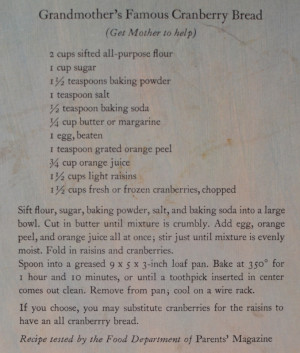
#6 Pumpkin Bread
This recipe for Downeast Maine Pumpkin Bread is terrific. And I’m not saying that just because I’m from Maine–I’m backed up by the 5,000 people who have reviewed it! It makes three loaves, so there is plenty to freeze.
#7 Rhubarb Bread
Every old garden in Maine has rhubarb growing in it. This recipe that was once listed in a local newspaper makes a delicious sweet bread from the tangy stalks.
- 1 1/2 cups packed brown sugar
- 2/3 cup vegetable oil
- 1 egg
- 1 cup buttermilk
- 1 tsp. salt
- 1 teaspoon baking soda
- 1 teaspoon vanilla
- 2 1/2 cups flour
- 2 cups diced rhubarb
Mix brown sugar and oil until smooth. Add egg, buttermilk, salt, soda, vanilla and flour. Blend until moist. Fold in rhubarb. Pour into two greased loaf pans and bake at 350 degrees for 50-55 minutes or until a toothpick inserted near the center comes out clean. (By the way, if you don’t have buttermilk just put one tablespoon of vinegar into a measuring cup, add milk to make 1 cup total liquid and let stand for 5 minutes before using.)
#8 Scotch Tea Muffins
These are plain muffins that are perfect for pairing with homemade jam. The recipe came from an old Canadian cookbook my mother treasures.
- 2 tablespoons butter
- 1 egg
- 4 cups flour
- dash salt
- 1 1/4 cups sugar
- 1 1/4 cups milk
- 4 teaspoons baking powder.
Mix dry ingredients. Then add wet ingredients. Bake at 350 degrees fro 15-20 minutes.
#9 Whole Wheat Bread
I love this Simple Whole Wheat Bread recipe from Allrecipes.com. It makes three loaves so the work involved really pays off and I’ve had wonderful luck with it. When I first started making it I tried freezing the dough before it rose at all, freezing after the first rise and freezing after it was baked. The already baked bread tasted wonderful from the freezer and the bonus: that was the easiest, too, because it can be taken right out of the freezer, thawed and enjoyed just like fresh baked. If anyone has frozen store-bought bread before you may notice the texture suffers after you thaw it. This is not the case with homemade bread–trust me!
#10 Zucchini Bread
And last, but certainly not least, a recipe for Zucchini Bread from Allrecipes.com. If your children balk at the idea just feed it to them first before you tell them what’s in it. My children love this bread.
What Will We Do During Tea Time?
- We’ll read poetry aloud with a goal of memorizing one poem each month.
- Homeschool Share has regular Tea Time posts with information and links for studying poets, composers, and artists.
- These next two resources have helped expose and educate me along with my children in subject areas that were challenging for me. I had almost no experience or knowledge in fine art and music and these resources from fellow homeschool moms are invaluable.
- Fine art and music appreciation is planned for you with Harmony Fine Arts. We’ll be using Grade 5 this year to go along with our history studies.
- Mary from Homegrown Learners shares her classic music appreciation technique of Super Quiet UnInterrupted Listening Time. I’m an affiliate for her just-released ebook with 10 SQUILT lessons because I honestly love this resource. The information she shares on each piece of music is crucial for me to share intelligently with my children. Click here to visit Homegrown Learners.
Hop over to iHomeschool network for more top ten lists.
This blog hop series was inspired by Angie of Many Little Blessings where you’re welcome to link up, too!
Summer Habit Training with a Weekly Schedule
After finishing up our second year of homeschooling with a week of testing, it was time for some relaxation. So for the past two weeks we’ve spent some time on the beautiful coast of Maine and taken some walks in the woods to refresh.

It was a great time for reflection on the past year–what went well and what needs some tweaking. I’ve been reading (and rereading) some of my favorite homeschooling books and grabbing some inspiration from my favorite blogs.
Time for Some Habit Training
Those of you familiar with Charlotte Mason’s methods know that a tool she advocates is the use of habits, and this is an area where we need some work. Which is really to say that I, as the mother, need some work.
The mother who takes pains to endow her children with good habits secures for herself smooth and easy days; while she who lets their habits take care of themselves has a weary life of endless friction with the children. ~ Charlotte Mason (Volume 1, p. 136)
I am often inspired by Barb’s wise council as a Charlotte Mason style homeschooler just graduating her third child. A post she wrote about instilling habits in her older children is full of ideas and advice and prompted me to focus on some housekeeping habits during our more relaxed summer schedule. I have been working on chores with my children, attempting to line up their responsibilities for taking care of their spaces and belongings and also contribute to overall household cleanliness. We have made some headway:
- They each have a checklist for getting ready in the morning, which is helpful in cutting down the numbers of times I have to say “Did you pick up your dirty clothes?” or “Did you turn off your bedroom light?” I still find myself having to remind them to go check their list for forgotten items, however, and with the list posted upstairs I can forget my responsibility to see that they have checked off the items. There is no record from day to day, so I feel the lines of habit have not been laid firmly enough for these daily tasks to become second nature.
- I added a daily household chore for each child. These are different each day and involve things like sweeping or wiping down bathroom counters and when done they really help keep the house cleaner during the week before my rounds of weekend deeper cleaning. I kept the list of specific chores on my desk, so here again I found myself forgetting to remind them and many days the chores went undone.
The room for improvement is making these tasks that they are fully capable of into a habit with no need for reminding by me. Taking care of these habits over the summer should let us focus on other habits when full time schoolwork picks up in the fall.
Last year I used a checklist for my daughter to increase independence in her school work and it worked very well. I modified the lists and made each of my children a summer weekly checklist.
Summer Weekly Schedule Checklist
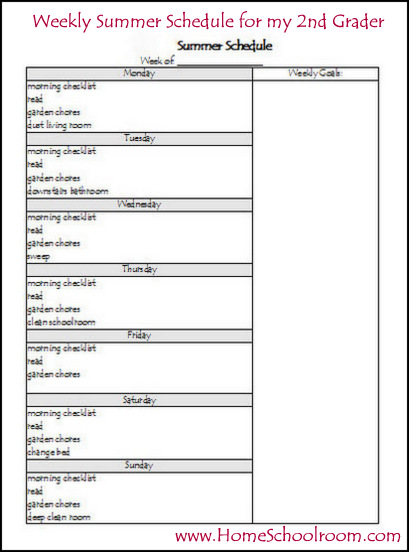
Each of them has daily tasks on their schedule:
- Morning checklist: the hope is this will cut down on me having to remind them to complete this list.
- Read: they have reading goals specific to their age, and this is here to make sure each of them reads every day.
- A household chore: again, with the item on their checklist I hope to cut down on the need for reminders from me.
- Garden chores: they each have their own square foot garden, so they need to weed and water it each day. My daughter showed extra interest in flowers this year so she also has several potted plants outside that will be her responsibility.
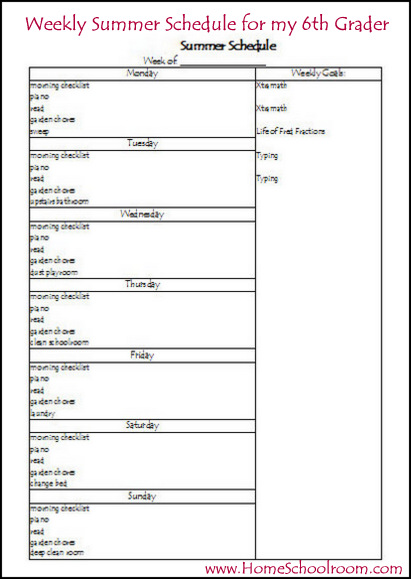
My daughter’s list has additional items:
- Daily piano practice
- Some tasks that need to happen 1-3 times per week but the day is up to her (Xtramath, a chapter in Life of Fred, and typing practice)
- I also plan to check in with her each Monday to help her in setting some personal goals she can add under “weekly goals.” I found this helps keep her productive in her free time. We set goals like making something (she sews and loves duct tape crafting) or organizing a section of her room (something she actually enjoys!) or writing a letter to someone (she has several girls she exchanges letters with).
These checklists give us all a central place to keep track of chores and also keep a record of how they are doing at accomplishing each item each day. The final piece is a reward for weekly lists with all items checked off. I’m still debating the specific reward–a trip to Dunkin’ Donuts for breakfast, or possibly good old cash.
In case any of you are also looking to make your life with your children easier by forming good habits Simply Charlotte Mason offers a free ebook that I just stumbled across today called Smooth and Easy Days. Do you have any specific summer goals for your children or any advice for me as we focus on habits?
Thank you to the wonderful hostesses with fun link-ups. Be sure to join the fun and see what other homeschoolers are up to!
Quiet Time, Oh How I Love Thee!
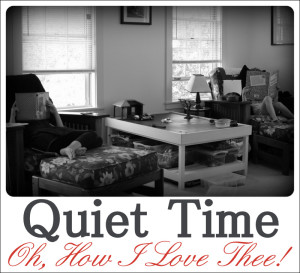
One of the biggest challenges for me when I began homeschooling was the sheer amount of talking and interaction required. Though I was accustomed to having both children home all the time in the summer, teaching them for hours left the introvert in me a bit drained by afternoon. As the rest of the day loomed before me I fondly reminisced about afternoon naps.
There were days when my ears actually hurt and even the sound of them playing in the next room was stressful. {This is when those of you with double or triple the number of kids I have are laughing–I know, I’m a wimp.} I also noticed frequent squabbling during afternoon play because they had been together all day, too!
Enter a homeschool mom’s secret weapon: Quiet Time. The first wise, experienced homeschool mom to reveal this delightful idea to me was Tricia at Hodgepodge. (I always pore over her blog soaking up her wisdom.) I also read a great post from Jamie at The Unlikely Homeschool with her version of quiet time.
I realized this would save my sanity. We tried various arrangements of locations and activities and I nailed down my goals for quiet time (other than just a few blessedly quiet moments to myself). We now have a plan that works for us.
One Hour of Quiet
Quiet time lasts one hour, per Mommy’s timer. Do not ask how many minutes are left. Just remain in your quiet spot until you hear the beep.
The supreme rule of quiet time is that you must be quiet. No talking–especially not to Mommy. I play classical music from our composer of the month during quiet time. The two benefits: my children hear a lot of wonderful music, and it serves as a reminder that this isn’t the time to talk to your family members. (Even if you just saw a picture of a really disgusting bug or wrote the funniest part of your story.)
You must gather what you need before quiet time to prevent getting up during the hour. You may choose the comfortable spot to spend the hour and surround yourself with pleasant, quiet activities.
You must spend some of the time enjoying a good book: my ten-year-old daughter is required to read one chapter, my seven-year-old son must look through one book or listen to an audio book.
We try to fit quiet time in most days, though it often only works on the days we don’t have outside engagements. Sometimes it happens in the early afternoon, sometimes when we return from an errand or meeting, and sometimes I pull it out in that pre-dinnertime hour (especially if Daddy, our chef-in-residence, is home to prepare the meal).
The Quiet Cupboard
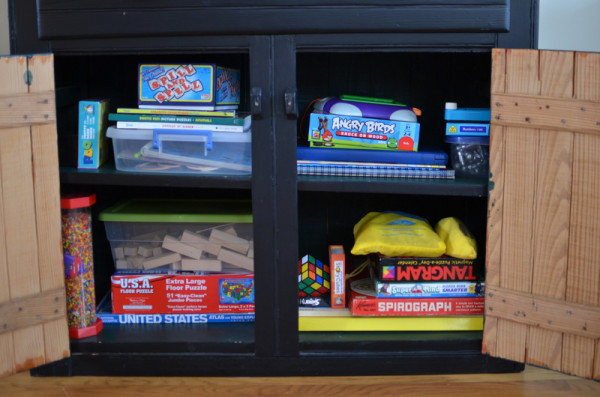
The first day I implemented the “Quiet Cupboard” my kids couldn’t wait for quiet time. The simple idea of arranging an assortment of quiet-time-permissible activities inside a cabinet piqued their interest. The lower shelf has activities good for either child, the top shelf has one side for my daughter and one for my son.
They are welcome to choose things that aren’t in the cupboard but they both gravitate toward the chosen activities. I try to switch it up over each weekend. No massive overhaul needed, just a few changes. They continue to look forward to seeing what’s in the cabinet, and the variety of activities they engage in has increased since the quiet cupboard’s introduction.
What Goes Into the Quiet Cupboard?
Well, the ideas are practically endless, but here’s what you’ll find, on a rotating basis, in our cupboard:
- 1-person games:
- Scrabble Flash
- Spill and Spell
- Chocolate Fix
- PDQ: The Pretty Darn Quick Word Game
- Bananagrams (the tiles can be fun to play with, my daughter makes intersecting words on a theme for fun)
- Rory’s Story Cubes
- Tangrams (we use an old page-a-day magnetic calendar)
- Supermind
- Find It
- Puzzles (I especially love to slip geography puzzles in here)
- Blocks: our Legos are out constantly, but I’ll put other smaller block sets in here like Lincoln Logs or Tinkertoys
- Clipboard with paper and pencils–these can be used with some of the activity books or by themselves for drawing or writing
- Activity books:
- How to Draw (fill in the blank) books: we have ones for animals, people, and even military vehicles!
- Mazes
- Crossword puzzles
- Doodling books: Doodles at Dinner is one of my daughter’s favorites
- Visual search books like Hidden Pictures, Where’s Waldo, or Photo Fun
- Soduku
- Art and craft supplies that don’t make big messes (not the time for ink pads, paints or chalk pastels)
- Stencils
- Klutz books are always a hit: quilling, friendship bracelets, paper airplanes, cat’s cradle, Spirograph
- Do-a-Dot markers
- Card kit: I put together a box with blank cards, fancy edge scissors, and cardstock scraps
- Books: though they can choose a book from anywhere, if I want to draw particular attention to a book I’ll put it in here. Books from the library or home, maybe one with beautiful artwork or photography, maybe one that goes with our season or studies (nature, science, history, art–so many choices!)
After Quiet Time
I can be a little tempted to keep my nose in a book or working on whatever focused task I was doing. But (most days) I resist the urge and jump back into family life. I take the time to admire creations, listen to story lines, or examine interesting finds from our hour “apart.” We all enter our evening refreshed and ready to enjoy each other.
Do you practice quiet time in your home? Share your version in the comments!
*This post contains affiliate links.
